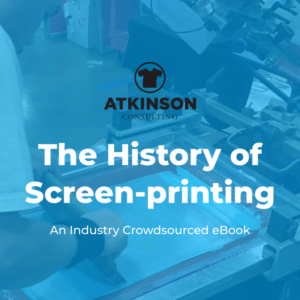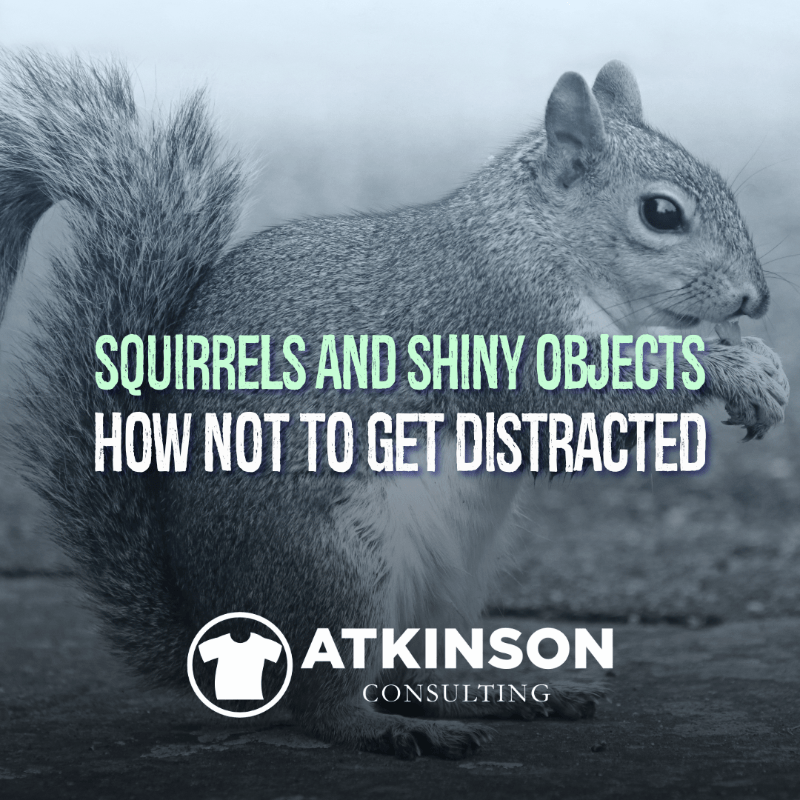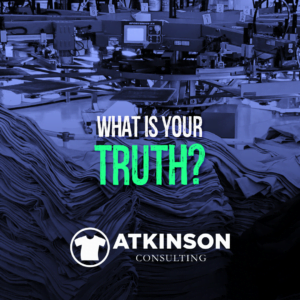Distracted at work?
Have you ever wondered how other people and companies seem to accelerate and do so much more than you every day?
I named this article “Squirrels and Shiny Objects” because it seems that for some folks they veer off the path of what they need to be doing as soon as something interesting pops up in view.
“Hey look, a squirrel!”
or
“Ooohhh, a balloon.”
All kidding aside, that doesn’t have to be you.
The secret is focus and some time management ninja habits. So grab another cup of coffee, and let’s breakdown some things that can make an immediate impact on how you get things completed every day.
First, Watch This Video
To begin the article, let’s chat about “Selective Attention”.
Sure, Selective Attention is what my wife might say I have when she’s talking and I’m focused on something else. That’s a different type of being distracted. (I’m not ignoring you, I’m focusing!)
But in the business world, this is serious business. Here’s a famous video by Daniel J. Simons that illustrates that aspect. In the video, there is a group of kids passing a basketball back and forth. You simply need to count how many times the players wearing white pass the basketball.
Use a piece of paper and write down your number. It sounds easy, but it isn’t.
Take the challenge!
Press pause when the screen goes black and it shows “How many passes did you count?”, after the kids are finished with the exercise.
So, how many did you count?
11?
14?
15?
20?
Hopefully, you were paying close attention and nailed the right number. Did it match what you wrote down?
But did you see anything else in the video?
This is what happens when we focus so closely on something, that we ignore everything else around us. Your eyes simply don’t recognize any stimulus that isn’t part of what we are targeting. That’s being distracted, but at a truly weird and astonishing level.
Miss Something?
That’s why you missed the gorilla walking through that crowd of kids.
Yep. A gorilla.
Watch it again.
Now think about all those times in your shop where you were so intently focused on one thing, that the “easy” thing got missed or you made a mistake. That’s that gorilla walking through your shop.
By the way, if you were lame enough to just keep reading and didn’t watch the video as instructed, and then went back and watched it, the trick won’t work. In fact, you will be shocked that anyone could fall for it. So, to prove my point you now have to share this with someone on your team.
Don’t tell them about the gorilla. Have them focus on the basketball passes instead.
But now, when you have them watch the video this becomes a distraction.
I still win.
Not Distracted Game Plan
Next, let’s talk about “putting first things first”. In this industry, it is amazingly easy to start racing down the road after some tangent. When you look up, hours have gone by and the important things you had to do today aren’t even remotely started.
A good game plan for handling the important things begins with one simple word.
Process.
Having a solid process removes the flakiness of people from the work. It’s not Billy’s way of doing something, but the “company way”.
A good process starts by detailing all of the steps necessary to handle the work.
For example, quotes aren’t handled by scribbling the math on a yellow legal pad. Instead, there is a system in use and any trained person quoting an order for a customer will arrive at the same answer as everyone else. The process defines the math for the quote and even how and when to follow up with the customer.
This should be true for every department, and every task.
A good process sets up the rules and expectations for your business to run properly.
Priorities Within The Process
Another level of planning within your process is how you prioritize the work.
Let’s say you have five quotes to send to customers or seven orders that need artwork created. Which one would you work on first? Second? Can you delegate one or two off to someone else?
Learning how to prioritize work is easy if you set up some guidelines.
For me, the one thing that always works is to use the Ship Date as a keystone marker for work priority.
It’s logical.
Something that is due to ship in a few days has to have priority over something that is due to ship next week, right? This is why it is crucial to use real dates for your orders. I know a lot of salespeople and companies like to use padded dates, “just in case”. But that only leads to problems down the road.
Let’s face it. Not using the real Ship Date is mainly due to a lack of trust with your process. Fix that so you can prioritize the work correctly. Padded dates = lazy production management. Do it right so there is trust established.
As I’ve written before, I like to use the Ship Date and organize everything with these four ideas.
Rush
Rush orders are those that are paid to go faster or have some critical component in them that makes them a critical priority. These orders are always worked on first in every department. It is the equivalent of the Disney Fast Pass where you get to skip to the head of the line. This is true not just in production, but in purchasing, receiving, the art department, the screen room, even in shipping. Rush jobs get worked on first. Every. Single. Time.
Late
Rush orders have to go first, but after that, anything that is Late needs to be knocked out. Late jobs cannot get any later. This happens all the time, especially in high-concept areas like the art department. You can’t simply put tasks off because something better came up, or was tagged important by someone else. Stick to your process, and don’t get distracted.
Today
Today’s jobs mean those tasks that are scheduled for today. The Rush and Late work have to go first, and after that, anything that needs to be worked on or completed today is handled. It’s easy to cram in that “little thing” for Today ahead of another one that may be a Rush or Late task…but this is how that excuse, “Sorry, we just ran out of time, that Rush order didn’t ship”, happens. That’s when the Rush job or the Late job gets pushed out.
Tomorrow
This is critical. You can’t work on future work until the Rush, Late, and Today’s jobs are handled. Too many times that fun order for two weeks from now or that job for the donut-wielding salesperson gets jumped in front of everything else. Don’t fall into this trap.
Simply Not Distracted
Let’s assume you have built some solid functional processes. What’s next on the road to not being distracted? Here’s another clue for you: Keep things simple.
Don’t get sucked into the vortex of distractions by limiting the things you are doing at one time. You can not multitask and do good work.
You need to be present. Here and now.
Your priorities should be:
- Start a task.
- Work the task.
- Finish the task.
Instead what is more common:
- Start a task.
- Check your email.
- Get back to the task.
- Look at your cell phone to see who liked your recent Instagram post.
- Get back to the task.
- Go to the bathroom.
- Stop by the breakroom for coffee.
- Have a conversation about Game of Thrones. “What was crazy was that Arya and Gendry hooked up. Our little assassin is growing up.”
- Check your email.
- Get back to the task.
- Go to a production meeting.
- Check your email.
- Respond to a few of the emails with follow-ups
- Get back to the task.
- Forget what you were doing.
- “Oh yeah!”.
- Finish the task.
How to Keep Things Simple
If you want to limit how you get distracted try sectioning off blocks of time into chunks. Try using 30-minute or 60-minute blocks, and color code them on your calendar. During that time you focus on whatever that scheduled time is about. Don’t answer any emails or take a phone call. Those can be responded to later.
When that segment is up, move onto the next thing that is scheduled.
That’s when those tasks are handled. Leave unscheduled time on your calendar for those tasks that always seem to come up.
Use a Kitchen Timer
For some, a good trick might be to get a cheap kitchen timer that winds up. Set it for whatever chunk of time you need to designate, and then keep your head down working on it until the timer dings. How much work could you do if you worked UNINTERRUPTED for 30 or 60 minutes at a time?
I know, I know. It seems dumb to have to use a kitchen timer to get work accomplished, but this tip works for those that are easily distracted. Try it!
Emails
A trick that has worked for me for years is to only respond to emails three times a day. Morning, midday, and before you leave. I call it the “Breakfast, Lunch, and Dinner” plan. It’s the best way to not let emails get you distracted from the main work that needs to be handled by you.
The first thing in the morning is when you respond to anything that came in after hours. Get those handled and any outgoing follow-ups that need attention. If you need to write some outgoing emails, do them now.
Then, put your email priority aside and work on other things. Like printing or embroidering shirts. Or making sales calls.
After lunch, respond to anything that came in. Write some more, and then leave it alone.
Get more crucial work handled. Remember, don’t look at those emails. You will do that later.
Right before you leave, check your emails again. Get those handled and then that’s it for the day.
Then, and most importantly, when you get home leave that work stuff at the office. No matter the temptation, do not look at your work email away from the office.
Your family and friends need you too.
Deflect
“Hey, Marshall I just need a minute to talk about the…”
Hold on. Do you get this type of drop-in interruption on a regular basis? I hate them. You lose focus and it’s hard to get back on track with what you were working on.
If you have an office door, let everyone know that when the door is closed it is your focused time. But maybe you work in an open-air cubicle or just have persistent people that need their questions answered.
The trick to use a verbal judo move.
“Oh hey, Cheryl. I’m in the middle of something. Can I come find you in thirty minutes and we can discuss? Thanks!”
If you don’t want to be distracted by whatever Cheryl wants to talk about, you need to take matters into your own hands. This phrase allows you to wrest control of the conversation and lets Cheryl know she’s important. It gives her a timeline on when you are going to find her. Cheryl will walk away happy, and you can finish that priority task you were neck deep in when she stuck her head in the door.
Plan Your Day
Personally, I like doing the most important things first.
As in, it is the very first thing I’m working on that day. Or better, I kicked it’s butt yesterday.
But one thing I’ve learned in running shops all these years is that for me, there are only about two or three major tasks that can be handled a day. These are the gigantic, time-sucking projects that you get straddled with. That’s because there are simply too many things going on in your business. Don’t over-plan by adding too many tasks on your to-do list.
Once you get distracted with some challenge that needs your attention, not all of those items are going to get handled.
Be Realistic
Instead, be realistic about how long things take.
Planning a review for your employee’s compensation for next year? Building a pivot table for a spreadsheet that will analyze all of your production data with color-coded macros? Receiving a floor-loaded truck with inventory for that new client?
These things take time to handle.
I’ll bet you have big projects on your plate as well. So why do we cram a dozen of these on our to-do list for a day? It’s just not realistic time-wise.
Unless…
You Delegate
That’s right. You’ve heard of that before, right?
Sadly, most leaders that I speak with feel that they have to own and do everything in their shop. Here’s a tip.
You don’t.
It’s 100% ok to give your tasks away to other people. In fact, they don’t even have to work in your building.
You can outsource office type tasks to virtual assistants. Artwork can be handled with a separate creative team such as PixelsHive. HR and payroll chores can even be handled with a service.
Think about everything you have to do today. Is the reason you keep putting some of the things off on your list is because you don’t really like doing it or don’t have the skill? Get someone else to do it and move on.
The Importance of Breaks
It’s a fact. Your brain needs downtime.
This means you need to occasionally go do something else. Go talk to people. Take a walk. Break a sweat.
Want more focus? Take more short breaks.
I think one of the greatest features in some of the new smartwatches is the ability to monitor your body and tell you to get up and move around.
Hey, I’m guilty of sitting in a chair for hours working too. Raising my hand right here. However, after I finish one task and before I start another I will get up and move around. Get some water. Do something different. It really helps me focus my concentration for the next round of activities.
You can do it too.
To get rid of old bad habits you have to replace them with something else.
Be the change you seek.
“Never neglect details. When everyone’s mind is dulled or distracted leaders must be doubly vigilant.” – Colin Powell
“I don’t think we realize just how fast we go until you stop for a minute and realize how loud and how hectic your life is, and how easily distracted you can get.” – Meg Ryan
“I think we get so distracted with our smartphones… It takes your body and your brain to switch between tasks. If we can focus on what we are doing, we can be more productive at that task.” – Yael Cohen
Maybe You Need A Distraction?

I’m being ironical of course.
However, I would really love it if you would take a few minutes and contribute to my crowdsourced eBook, “The History of Screen-printing”.
I’ve always been fascinated by how people get into the decorated apparel industry. Everyone has a unique path into the crazy business. The purpose of the book is for people, just like you, to share their story.
My goal is to get between 100 and 200 people to contribute their journey into the industry. I don’t care if you have been doing it for six months or sixty years, let’s hear about your path into the business!
How did you get started? Who influenced you? What have you learned?
Please take a moment and join in the fun!
[av_button label=’Share Your Story’ link=’manually,https://marshallatkinson.typeform.com/to/Yv85ui’ link_target=’_blank’ size=’x-large’ position=’left’ label_display=” icon_select=’no’ icon=’ue800′ font=’entypo-fontello’ color=’theme-color’ custom_bg=’#444444′ custom_font=’#ffffff’ av_uid=’av-skzvwt’ admin_preview_bg=”]





